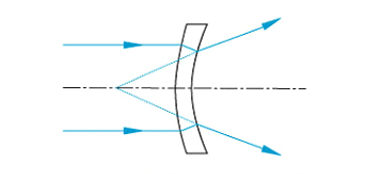Bent moon lenses are commonly used in multi-component optical systems to modify focal length without introducing significant spherical aberration. The optical performance of multi-element lens systems is usually significantly better than that of single lens systems. In these systems, aberrations introduced by one component can be corrected by subsequent optical components. These lenses have a convex surface and a concave surface, and they can be positive or negative lenses.
Positive crescent lens:
A positive meniscus lens is typically used in conjunction with another lens in composite optical assemblies. When used in this structure, a positive meniscus lens will shorten the focal length, increase the numerical aperture (NA) of the system, and will not introduce significant spherical aberration.

Negative crescent lens:
Negative crescent lenses are usually used together with another lens in composite optical assemblies. When used in this structure, a negative meniscus lens will increase the focal length and decrease the numerical aperture (NA) of the system.

| Key Specifications | |
| Material | Optical glass Optical crystal |
| Diameter | 3-650mm |
| Shape tolerance | ±0.015 |
| Surface Quality | 20-10 |
| Surface Flatness | λ/10 |
| Angle tolerance | <30″ |
| Effective aperture | 85% |
A Meniscus lens is a special type of lens that has a convex surface on one side and a concave surface on the other, and the centers of curvature on both sides are not consistent, resulting in a crescent shaped appearance for the lens as a whole. This lens design can be used to improve the imaging performance of optical systems, especially in reducing spherical aberration and improving imaging quality.
application area
Curved crescent lenses are widely used in various optical systems, including but not limited to:
- Lens:Used to improve imaging quality and reduce distortion.
- glasses:Especially used for correcting farsightedness and nearsightedness, providing a more comfortable visual experience.
- LASER SYSTEM:Used to adjust the focusing state of the laser beam, improve the accuracy and efficiency of the laser.
- Astronomical telescope:Used to improve the clarity and accuracy of observations.
- optical instrument:Used in various optical measurement and analysis instruments to improve optical paths and imaging effects.
advantage
- Reduce spherical aberration:A crescent shaped lens can effectively reduce spherical aberration and improve imaging quality.
- Wide applicability:It can be customized according to different optical system requirements to meet diverse application scenarios.
- Excellent imaging performance:A properly designed crescent shaped lens can provide very clear and accurate imaging effects.
The crescent shaped lens plays an important role in improving the imaging quality of optical systems due to its unique design and excellent optical performance. Through careful design and precision machining, crescent shaped lenses can meet the needs of high-end optical applications and become an important tool for optical designers and engineers.
| Curved crescent lens can process conventional indicators | |
| material | Optical glass, calcium fluoride, magnesium fluoride, silicon, germanium, zinc selenide, etc |
| Product Category | meniscus |
| Processing diameter (mm) | 1-600 |
| Diameter tolerance (mm) | ±0.03 |
| Thickness tolerance (mm) | ±0.03 |
| Surface smoothness (American standard) | 60-40 or 10-5 |
| Surface Accuracy | λ/ 10@632.8nm Or higher |
| Focal length error | ±2% |
| Optical aperture | >90% |
| core shift | <3 ‘or higher |
| chamfer | 0.2mmX45° |
| coating film | Customize according to demand |







![1678850150623f0c8f1684c-1024x1024[1] 1678850150623f0c8f1684c-1024x1024[1]](https://asphericoptics.com/wp-content/uploads/2024/09/1678850150623f0c8f1684c-1024x10241-1-1024x701.jpg)